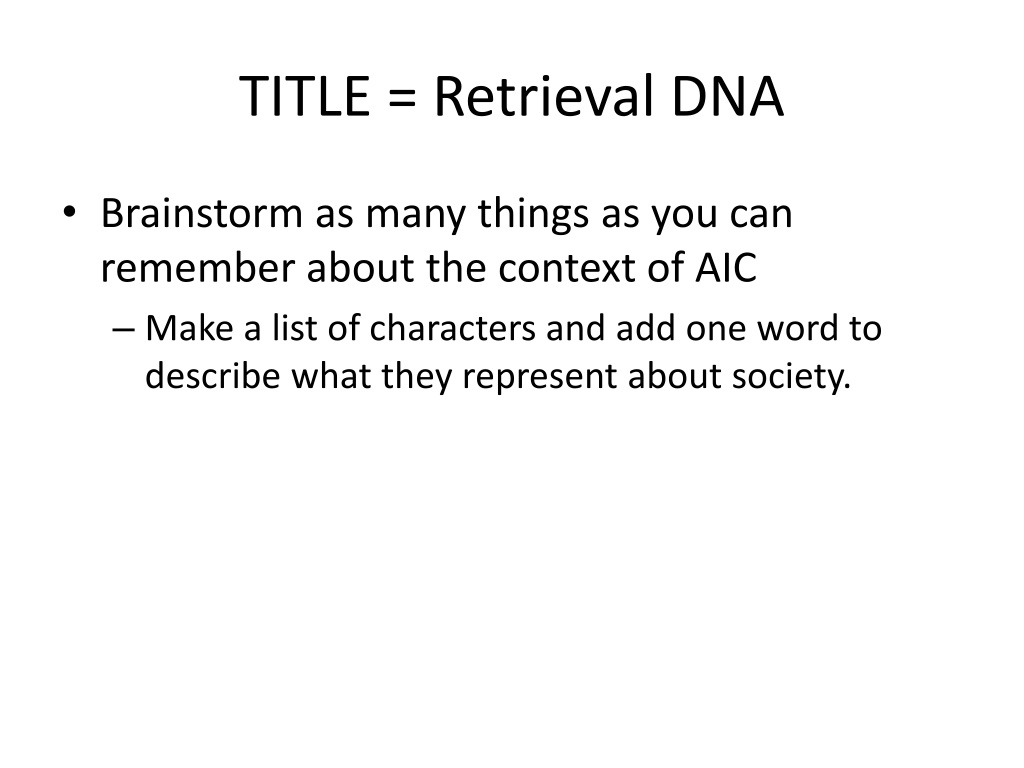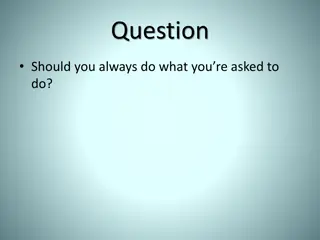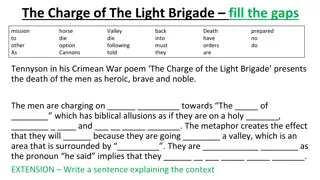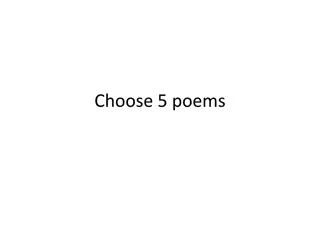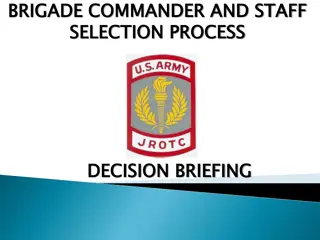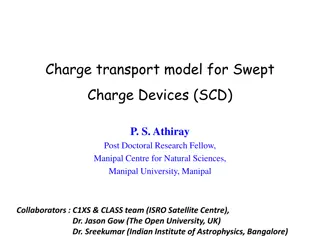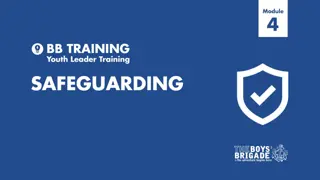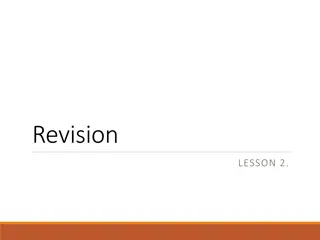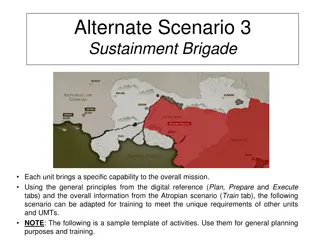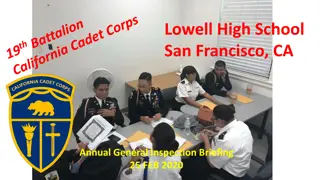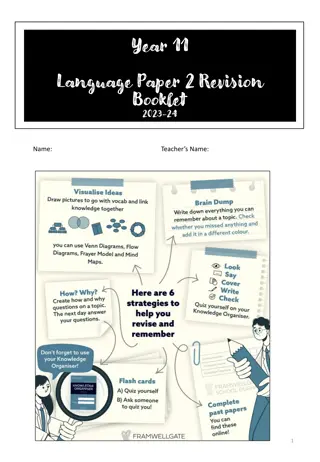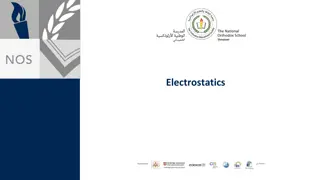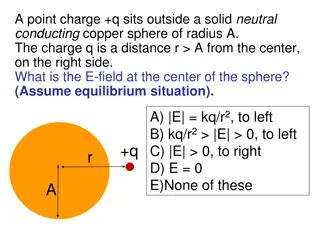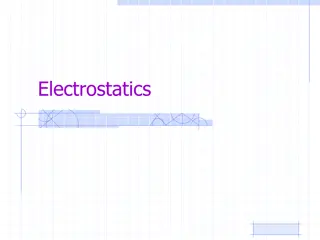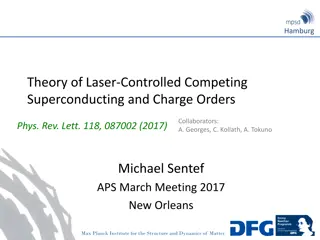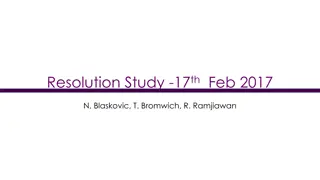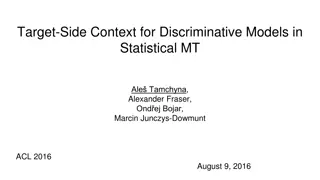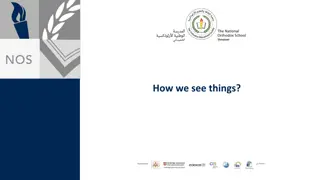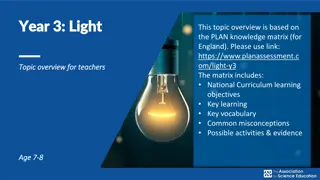The Charge of the Light Brigade: Historical Context and Analysis
Explore Alfred, Lord Tennyson's poem "The Charge of the Light Brigade" in the context of the Crimean War. Understand the tragic events of the Battle of Balaclava in 1854 that inspired this work. Analyze the characters, themes, and societal reflections within the poem.
Download Presentation

Please find below an Image/Link to download the presentation.
The content on the website is provided AS IS for your information and personal use only. It may not be sold, licensed, or shared on other websites without obtaining consent from the author. Download presentation by click this link. If you encounter any issues during the download, it is possible that the publisher has removed the file from their server.
E N D
Presentation Transcript
TITLE = Retrieval DNA Brainstorm as many things as you can remember about the context of AIC Make a list of characters and add one word to describe what they represent about society.
Lesson 1: Charge of the Light Brigade Learning Objective: To begin to explore the poem
Alfred, Lord Tennyson File:Alfred Lord Tennyson 1869.jpg Today we will be studying the poem The Charge of the Light Brigade but before we read the poem we need to find out a little bit about the author. Alfred, Lord Tennyson was born in 1809 and died in 1892. He was thought of as one of the great poets of the Victorian age.
Social and Historical Context The poem is based on an actual historical event. It is set in 1854 during the Crimean War. It describes a terrible battle, the Battle of Balaclava, in which a mistake made by the commanding officer led to the deaths of many soldiers. Tennyson wrote the poem after reading about the battle in a newspaper.
The Charge of the Light Brigade recalls a disastrous military situation that took place during the initial phase of the Crimean War fought between Turkey and Russia (1854-56). Under the command of Lord Raglan, British forces entered the war in September 1854 to stop the Russians. From the beginning, the war was plagued by a series of misunderstandings and errors, one of which serves as the subject of this poem On October 25, 1854, Lord Raglan sent desperate orders to his Light Cavalry Brigade to fend off the Russians. The brigade began charging but in the wrong direction! Over 650 men rushed forward, and well over 100 died within the next few minutes. http://www.youtube.com/watch?v=uj5bilCQE DU history
Group of soldiers theyre called light to separate them from the heavy brigade 1. Brigade 2. League Measurement of distance. About 3 miles Feeling low and discouraged 3. Dismayed Mistake made through carelessness 4. Blundered Round of cannon fire 5. Volleyed Heavy sword with a curved blade 6. Sabre Smoke emerging after cannon fire 7. Battery Smoke A member of the Ukraine/Southern Russia - famous for their horsemanship and military skill 8. Cossack 9. Sunder d Broken in two 10. Honour First impressions: What is the poem about? To regard with high respect
Audio Reading Click on the image below to hear an audio reading of the poem.
What is it about? The poem is made up of six stanzas. Can you work out what is happening in each? Complete the table below: Stanza Stanza 1 What is happening? The poem begins in the middle of the action as six hundred soldiers charge onwards into the valley of Death Stanza 2 Stanza 3 Stanza 4 Stanza 5 Stanza 6
Stanza Stanza 1 What is happening? The poem begins in the middle of the action as six hundred soldiers charge onwards into the valley of Death Stanza 2 Soldiers are commanded to move towards doom. They realise this is a mistake but do as they are told because it is their duty. Stanza 3 Sensory description of the sounds of battle. Highlights the bravery of the soldiers as they face certain death. Stanza 4 Calvary only had swords against the Russian guns making them even more vulnerable yet they do have some luck images of brutal warfare. However they have gone as far as they can and must turn back. Stanza 5 The return trip is just as deadly. Image of soldiers and horses collapsing under the rain of gunfire. Emphasises how many have died. Stanza 6 Reminded that we should be in awe of these noble men. They are now legendary.
Imagery Tennyson uses imagery to describe the violence, drama, sorrow and glory of the battle. Pick out images from the poem which convey these emotions. Violence Drama Sorrow Glory The valley of death Charge for the guns
Lesson 2: Charge of the Light Brigade Learning Objective: To explore the finer details of the poem
DNA - Mood and atmosphere How would you describe the mood or tone of this poem? Choose words from the list below: angry romantic sad exciting reflective sorrowful dramatic regretful proud fearful Write three sentences explaining how the speaker feels about what happened during the battle.
Group Work You have 5 mins only to analyse your stanza. Use the guided questions to support your annotations. You will then present your findings to the rest of the class who will annotate their own copy of the poem.
Why does Tennyson tell us the exact number? What measurement is this? Why is it repeated? What does it sound like? What image does this paint? Why? What does this phrase make you think of? Half a league, half a league, Half a league onward, All in the valley of Death Rode the six hundred. Forward, the Light Brigade! Charge for the guns! he said: Into the valley of Death Rode the six hundred. What happens here? What has changed? Why is this important? Consider the context. Where have you heard this phrase before? Why is it important? Why is this word important? Why is it capitalised? Why is this repeated?
What does this question mean? This is a command. What is the effect? Why can t the soldiers reply? Forward, the Light Brigade! Was there a man dismay d? Not tho the soldier knew Some one had blunder d: Theirs not to make reply, Theirs not to reason why, Theirs but to do and die: Into the valley of Death Rode the six hundred. What is Tennyson doing here? Who is the someone ? A refrain is a repeated part of a poem, particularly when it comes either at the end of a stanza or between two stanzas. Why is this used here? Why are these three lines repeated? What is the effect of the rhyme? Who is the theirs ?
Why does the poet include the directions? Why is this word repeated? Who is the enemy? Cannon to right of them, Cannon to left of them, Cannon in front of them Volley d and thunder d; Storm d at with shot and shell, Boldly they rode and well, Into the jaws of Death, Into the mouth of Hell Rode the six hundred. Why is onomatopoeia used here? What is the effect of this adverb? What is the effect of personification here? How does it make the valley sound? Why is repetition used here?
What does this show about the weaponry? What does this word connotate? How does this make the battle sound? Flash d all their sabres bare, Flash d as they turn d in air Sabring the gunners there, Charging an army, while All the world wonder d: Plunged in the battery-smoke Right thro the line they broke; Cossack and Russian Reel d from the sabre-stroke Shatter d and sunder d. Then they rode back, but not Not the six hundred. What is revealed about the battle here? What technique is used here? What is the poet s intention here? How does this make the soldiers sound? Why is this word important? How does it make the soldiers sound? What has changed here? How does the reader feel? What does it hint at? What technique is used here? Why?
What has happened here? What does this show about the battle? Cannon to right of them, Cannon to left of them, Cannon behind them Volley d and thunder d; Storm dat with shot and shell, While horse and hero fell, They that had fought so well Camethro the jaws of Death Back from the mouth of Hell, All that was left of them Left of six hundred. How does the battle sound here? What technique is used here? What word reveals the poet s viewpoint? What has changed here? Why? Why is this word important? What stanza is mirrored here?
What is the effect of the Rhetorical Question? Why is this repeated at the end? When can their glory fade? O the wild charge they made! All the world wonder d. Honour the charge they made! Honour the Light Brigade, Noble six hundred! What is the effect of this exclamatio n mark? Why does the poet use a command here? Why is it repeated? Why is this adjective important?
Retrieval Starter Write a one sentence explanation of the following techniques: Metaphor Simile Adjective Verbs Personification Ceasura Enjambment Repetitions Rule of 3 Challenge: Write an example of each
